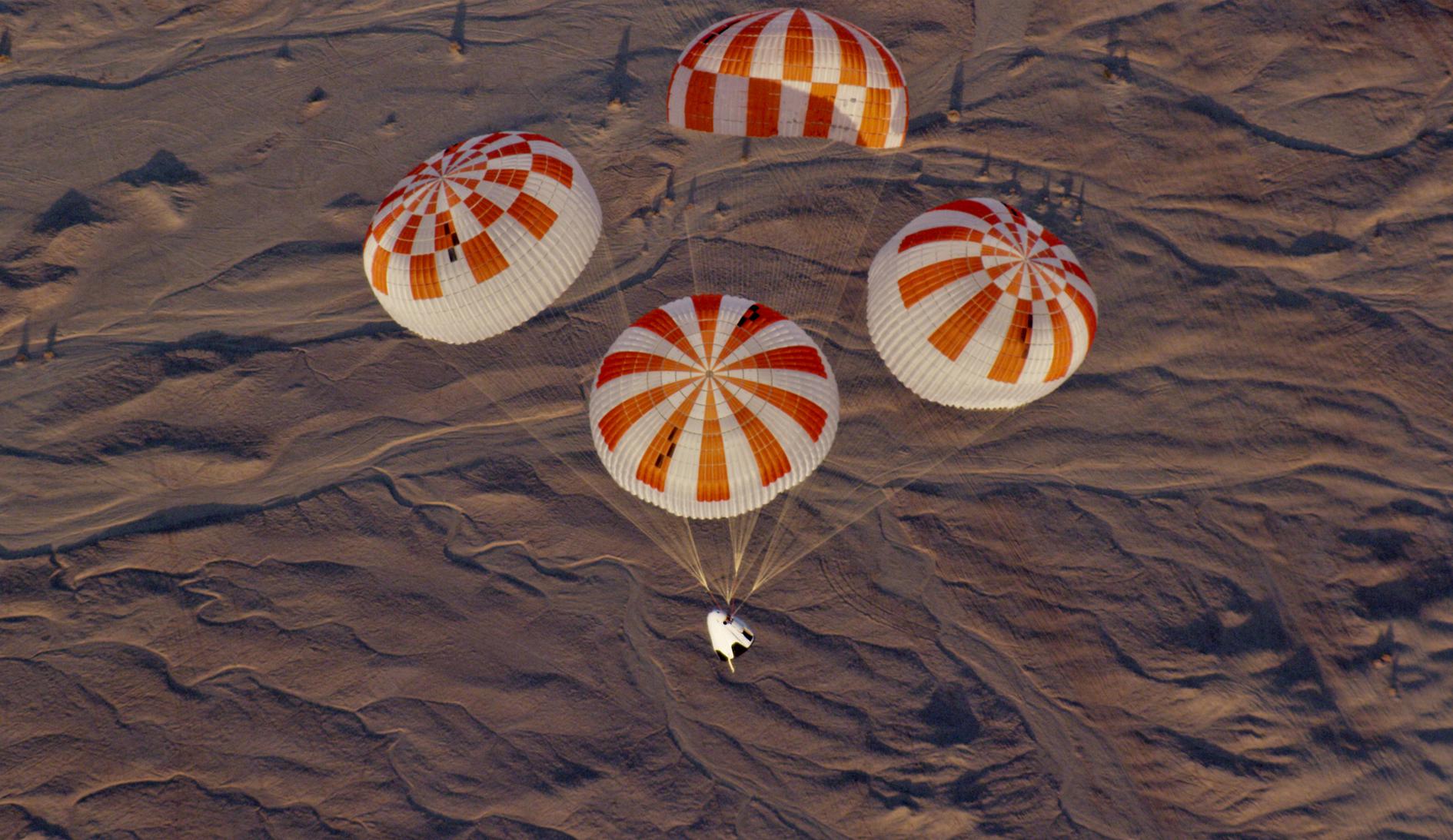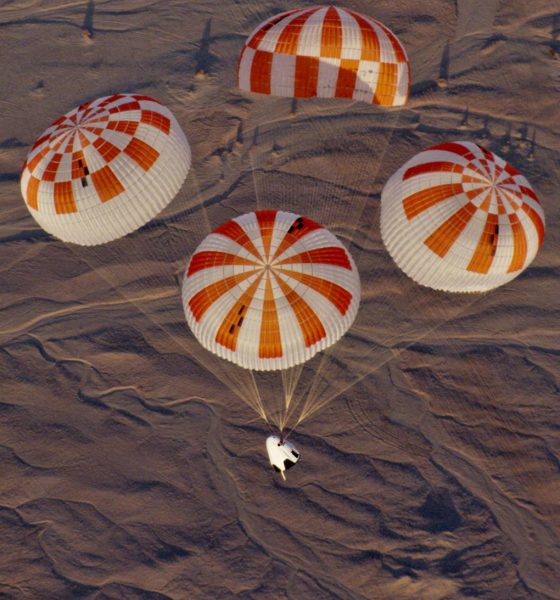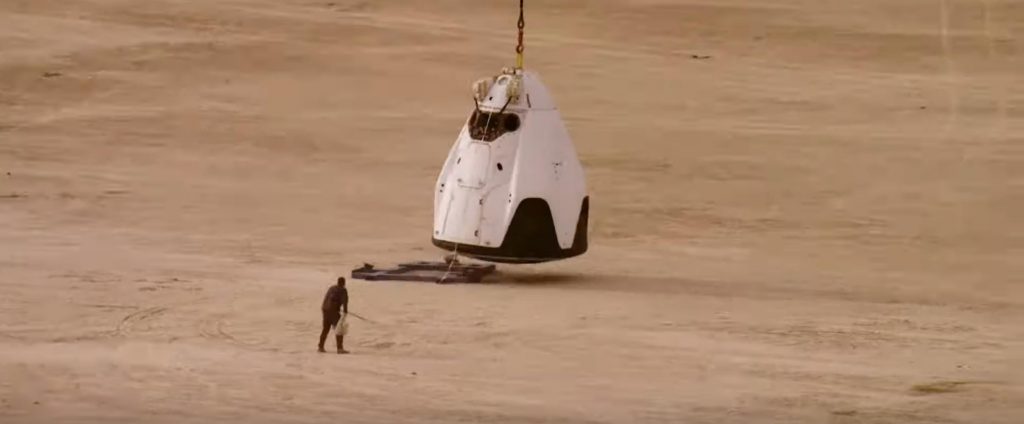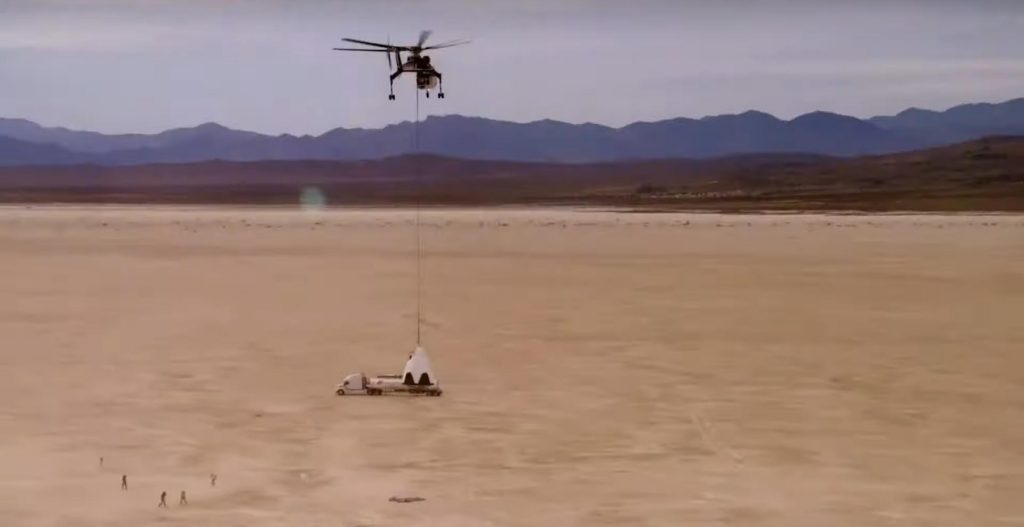

News
SpaceX dropped a Crew Dragon mockup to save a helicopter and its passengers
SpaceX says it encountered an issue that forced it to drop a Crew Dragon spacecraft mockup during parachute testing — not a failure of the vehicle or its parachutes, to be clear, but still a problem nonetheless.
This is now the second significant hurdle SpaceX’s Crew Dragon astronaut spacecraft has faced in the last few days, following the revelation that NASA will not permit the company to launch astronauts until it completes an investigation into an in-flight rocket engine failure during its March 18th Starlink launch. There is likely no technical corollary for the new Falcon 9 rockets that will launch NASA astronauts, but existing Commercial Crew Program (CCP) contract rules still require SpaceX’s internal investigation be completed before it can proceed. With lives on the line, caution – within reason – is unequivocally preferable to the alternative.
Thankfully, SpaceX’s parachute test article anomaly should have a much smaller impact on Crew Dragon’s astronaut launch debut schedule, but it’s unlikely to have zero impact.
“During a planned parachute drop test [on Tuesday], the test article suspended underneath the helicopter became unstable. Out of an abundance of caution and to keep the helicopter crew safe, the pilot pulled the emergency release. As the helicopter was not yet at target conditions, the test article was not armed, and as such, the parachute system did not initiate the parachute deployment sequence. While the test article was lost, this was not a failure of the parachute system and most importantly no one was injured. NASA and SpaceX are working together to determine the testing plan going forward in advance of Crew Dragon’s second demonstration mission.”
SpaceX — March 24th, 2020
On March 24th, SpaceX says it was preparing for one of the last system-level Crew Dragon parachute tests planned before the spacecraft can be declared ready for human spaceflight. These final tests are reportedly focused on corner cases, referring to unusual but not impossible scenarios the spacecraft might encounter during operational astronaut landing attempts. Those likely include parachute deployment scenarios that are far more stressful than a nominal reentry, descent, and landing would allow.
Regardless, things did not go as planned during Tuesday’s test attempt. SpaceX primarily uses cargo planes, helicopters, and large balloons to carry its Crew Dragon test articles (not actual functional spacecraft) to the altitudes and speeds needed to achieve certain test conditions. On March 24th, SpaceX was using a helicopter – either a civilian Blackhawk or a much larger Skycrane.



For unknown reasons, the helicopter carrying the Crew Dragon test article on March 24th began to experience “instability”, likely referring to some sort of resonance (wobble, sway, oscillation, etc). Out of an abundance of caution, the pilot – likely highly trained – decided the instability was becoming an unacceptable risk and chose to drop the cargo load (a Crew Dragon mockup). Unsurprisingly, the parachute test article was not ready to drop and plummeted to the Earth without any kind of parachute deployment, likely pancaking on the desert floor shortly thereafter.
Again, it needs to be noted – as SpaceX did above – that the loss of the Crew Dragon parachute test article was entirely unrelated to the performance of the spacecraft or the parachutes it was testing. The mockup destroyed in the incident is essentially just a boilerplate mass simulator shaped like a Crew Dragon capsule to achieve more aerodynamically accurate test results. As such, it’s far simpler and cheaper than an actual Dragon spacecraft and shouldn’t take long at all to replace if SpaceX doesn’t already have a second similar mockup ready to go.

Thankfully, that means that the loss of the test article should have next to no serious impact on Crew Dragon’s inaugural astronaut launch schedule. Planned no earlier than (NET) mid-to-late May according to NASA’s latest official statement, SpaceX and the space agency still have at least a month and a half to work through a final parachute test campaign, complete an investigation into Starlink L6’s Falcon booster engine failure, and finish several trees worth of paperwork and reviews. Delays remain likely but they shouldn’t be more than a few weeks, barring any future surprises.

News
Tesla dominates in the UK with Model Y and Model 3 leading the way

Tesla is dominating in the United Kingdom so far through 2025, and with about two weeks left in the year, the Model Y and Model 3 are leading the way.
The Model Y and Model 3 are the two best-selling electric vehicles in the United Kingdom, which is comprised of England, Scotland, Wales, and Northern Ireland, and it’s not particularly close.
According to data gathered by EU-EVs, the Model Y is sitting at 18,890 units for the year, while the Model 3 is slightly behind with 16,361 sales for the year so far.
The next best-selling EV is the Audi Q4 e-tron at 10,287 units, lagging significantly behind but ahead of other models like the BMW i4 and the Audi Q6 e-tron.
GOOD NEWS 🇬🇧 Tesla is absolutely crushing the UK electric vehicle market in 2025 💥
The numbers are in, and the dominance is clear. With an impressive amount of 42,270 vehicles delivered year-to-date, the brand now commands a solid 9.6% market share of the total auto market 🆒… pic.twitter.com/dkiGX9kzd0
— Ming (@tslaming) December 18, 2025
The Model Y has tasted significant success in the global market, but it has dominated in large markets like Europe and the United States.
For years, it’s been a car that has fit the bill of exactly what consumers need: a perfect combination of luxury, space, and sustainability.
Both vehicles are going to see decreases in sales compared to 2024; the Model Y was the best-selling car last year, but it sold 32,610 units in the UK. Meanwhile, the Model 3 had reached 17,272 units, which will keep it right on par with last year.
Tesla sold 50,090 units in the market last year, and it’s about 8,000 units shy of last year’s pace. It also had a stronger market share last year with 13.2 percent of the sales in the market. With two weeks left in 2025, Tesla has a 9.6 percent market share, leading Volkswagen with 8 percent.
The company likely felt some impact from CEO Elon Musk’s involvement with the Trump administration and, more specifically, his role with DOGE. However, it is worth mentioning that some months saw stronger consumer demand than others. For example, sales were up over 20 percent in February. A 14 percent increase followed this in June.
News
Tesla Insurance officially expands to new U.S. state
Tesla’s in-house Insurance program first launched back in late 2019, offering a new way to insure the vehicles that was potentially less expensive and could alleviate a lot of the issues people had with claims, as the company could assess and repair the damage itself.

Tesla Insurance has officially expanded to a new U.S. state, its thirteenth since its launch in 2019.
Tesla has confirmed that its in-house Insurance program has officially made its way to Florida, just two months after the company filed to update its Private Passenger Auto program in the state. It had tried to offer its insurance program to drivers in the state back in 2022, but its launch did not happen.
Instead, Tesla refiled the paperwork back in mid-October, which essentially was the move toward initiating the offering this month.
BREAKING: Tesla Insurance has just officially launched in Florida.
This is the first new state to receive @Tesla Insurance in more than 3 years. In total, Tesla insurance is now available in 13 U.S. states (map in thread below of all the states).
Tesla Insurance in Florida uses… pic.twitter.com/bDwh1IV6gD
— Sawyer Merritt (@SawyerMerritt) December 17, 2025
Tesla’s in-house Insurance program first launched back in late 2019, offering a new way to insure the vehicles that was potentially less expensive and could alleviate a lot of the issues people had with claims, as the company could assess and repair the damage itself.
It has expanded to new states since 2019, but Florida presents a particularly interesting challenge for Tesla, as the company’s entry into the state is particularly noteworthy given its unique insurance landscape, characterized by high premiums due to frequent natural disasters, dense traffic, and a no-fault system.
Annual average premiums for Florida drivers hover around $4,000 per year, well above the national average. Tesla’s insurance program could disrupt this, especially for EV enthusiasts. The state’s growing EV adoption, fueled by incentives and infrastructure development, aligns perfectly with Tesla’s ecosystem.
Moreover, there are more ways to have cars repaired, and features like comprehensive coverage for battery damage and roadside assistance tailored to EVs address those common painpoints that owners have.
However, there are some challenges that still remain. Florida’s susceptibility to hurricanes raises questions about how Tesla will handle claims during disasters.
Looking ahead, Tesla’s expansion of its insurance program signals the company’s ambition to continue vertically integrating its services, including coverage of its vehicles. Reducing dependency on third-party insurers only makes things simpler for the company’s automotive division, as well as for its customers.
News
Tesla Full Self-Driving gets sparkling review from South Korean politician
“Having already ridden in an unmanned robotaxi, the novelty wasn’t as strong for me, but it drives just as well as most people do. It already feels like a completed technology, which gives me a lot to think about.”

Tesla Full Self-Driving got its first sparkling review from South Korean politician Lee So-young, a member of the country’s National Assembly, earlier this week.
Lee is a member of the Strategy and Finance Committee in South Korea and is a proponent of sustainable technologies and their applications in both residential and commercial settings. For the first time, Lee was able to utilize Tesla’s Full Self-Driving technology as it launched in the country in late November.
Her thoughts on the suite were complimentary to the suite, stating that “it drives just as well as most people do,” and that “it already feels like a completed technology.”
드디어 오늘, 서울에서 테슬라 FSD 체험 했습니다.
JiDal Papa님의 모델S 협찬에 힘입어^^ 파파님 정말 감사합니다.
국회 -> 망원시장 -> 홍익대 -> 국회 복귀 코스였고요.
이미 무인 로보택시를 타봐서 그런지 신기함은
덜했지만, 웬만한 사람만큼 운전을 잘하네요.이미 완성된 기술이라고… pic.twitter.com/8pAidHBpRG
— 이소영 국회의원 (Soyoung Lee) (@im_soyounglee) December 17, 2025
Her translated post says:
“Finally, today I got to experience Tesla FSD in Seoul. Thanks to the Model S sponsored by JiDal Papa^^, I’m truly grateful to Papa. The route was from the National Assembly -> Mangwon Market -> Hongik University -> back to the National Assembly. Having already ridden in an unmanned robotaxi, the novelty wasn’t as strong for me, but it drives just as well as most people do. It already feels like a completed technology, which gives me a lot to think about. Once it actually spreads into widespread use, I feel like our daily lives are going to change a lot. Even I, with my license gathering dust in a drawer, don’t see much reason to learn to drive a manual anymore.”
Tesla Full Self-Driving officially landed in South Korea in late November, with the initial launch being one of Tesla’s most recent, v14.1.4.
It marked the seventh country in which Tesla was able to enable the driver assistance suite, following the United States, Puerto Rico, Canada, China, Mexico, Australia, and New Zealand.
It is important to see politicians and figures in power try new technologies, especially ones that are widely popular in other regions of the world and could potentially revolutionize how people travel globally.








